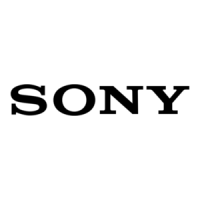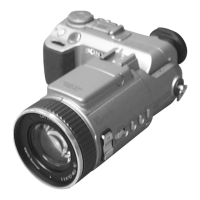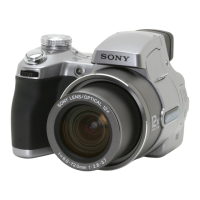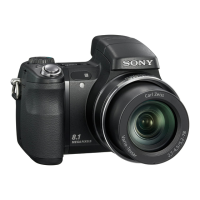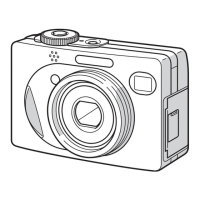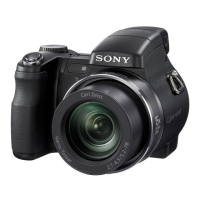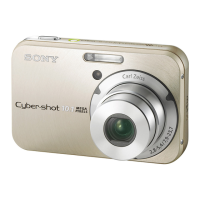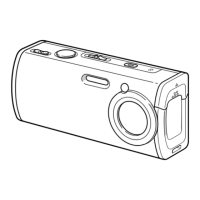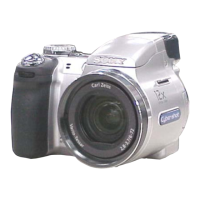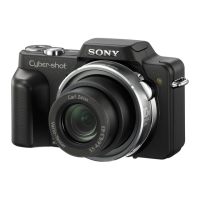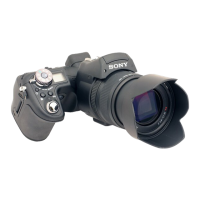
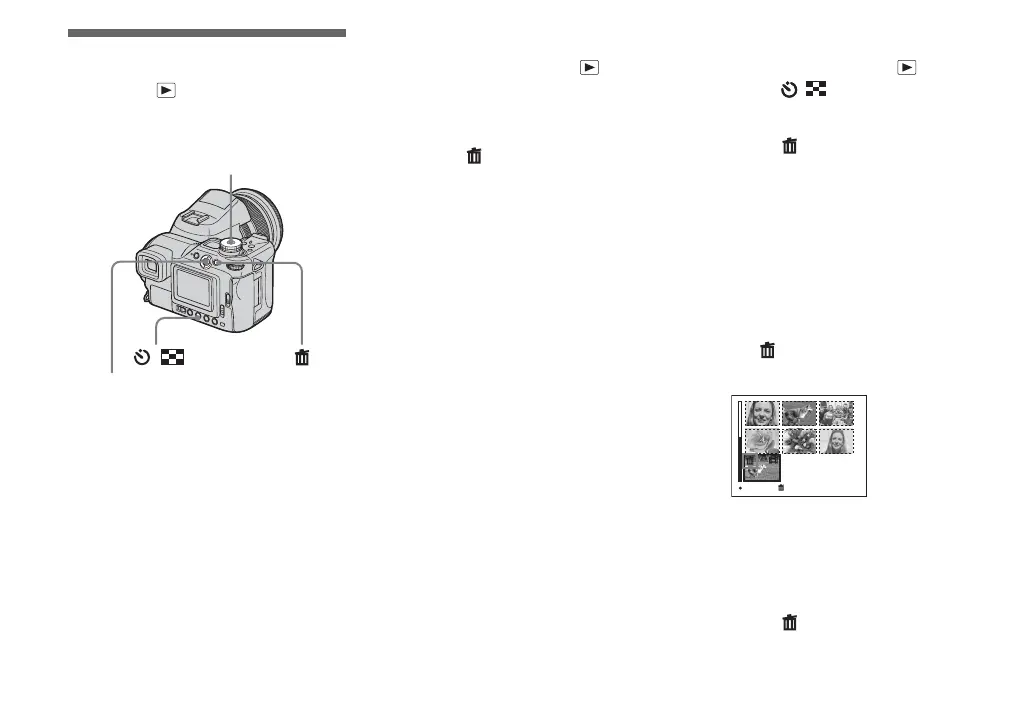 Loading...
Loading...
Do you have a question about the Sony Cyber-shot DSC-F828 and is the answer not in the manual?
| Sensor Type | CCD |
|---|---|
| Sensor Size | 2/3 inch |
| Resolution | 8.0 Megapixels |
| Image Processor | Real Imaging Processor |
| Lens Type | Carl Zeiss Vario-Sonnar T* |
| Optical Zoom | 7x |
| Digital Zoom | 2x |
| Aperture | f/2.0-2.8 |
| Shutter Speed | 30 - 1/3200 sec |
| LCD Screen Size | 1.8 inch |
| LCD Screen Resolution | 134, 000 pixels |
| Viewfinder | Electronic |
| Focal Length | 7.1-51mm |
| ISO Sensitivity | 64, 100, 200, 400, 800 |
| Storage Media | CompactFlash Type I/II, Memory Stick |
| Battery Type | NP-FM50 InfoLithium |
| Dimensions | 134 x 91 x 156 mm |
| Weight | 906 g (including battery and memory card) |
Record model and serial numbers for dealer reference.
Important safety warnings regarding fire, shock, and radiation hazards.
FCC compliance details and warnings about modifications to equipment.
Guidance on battery recycling, handling, and specific customer notices by region.
Notices for customers in the USA, Canada, Europe, and the United Kingdom.
Essential steps before use, including trial recording, data backup, and careful handling advice.
Instructions on proper handling to prevent damage from environmental factors and physical impact.
Details about the camera's Carl Zeiss lens and its features.
List of trademarks for various products and software used with the camera.
Labeled diagrams identifying buttons, dials, and components of the camera body and lens.
Instructions for attaching the lens cap and shoulder strap to the camera.
Guides on how to attach the lens hood for shooting and store it in reverse.
Step-by-step instructions for charging the battery pack, including insertion and connection.
Information on battery charging time and how to interpret battery remaining indicators.
Charts showing approximate images and battery life for different recording media and modes.
Instructions for AC adaptor use and camera operation abroad with plug adaptors.
How to power the camera on/off and details on the auto power-off feature.
Explanation of how to use the multi-selector for changing camera settings and navigating menus.
Step-by-step guide to setting the camera's date and time, including format selection.
Instructions for handling Memory Stick, Microdrive, and CF cards, including switching between them.
How to set the still image size using the camera menu and mode dial.
Step-by-step guide to shooting still images using Auto mode, including camera setup and shutter button use.
Detailed descriptions of various shooting modes available on the mode dial.
How to quickly review images, delete them, and adjust the camera's finder.
Explanation of screen indicators and how to display/interpret the histogram.
Explanation of Precision and Smart zoom modes, their functions, and limitations.
How to use the macro feature for close-up shots of flowers and insects, including focusing distances.
Steps for using the self-timer and understanding basic flash operation and modes.
How the hologram AF fill light assists focusing in dark surroundings and its technology.
How to set the camera to insert date and time information into images, with format options.
Explanations and usage of scene selection modes for different shooting conditions.
How to view images individually or as a nine-image index on the camera's screen.
Instructions for connecting the camera to a TV using the A/V cable for image playback.
Step-by-step process for deleting a single selected image from the camera.
Instructions on how to format media, with warnings about data loss.
How to access and change settings within the camera's menu system.
How to modify SET UP screen settings and use the command dial for adjustments.
How to choose image quality settings like Fine, Standard, RAW, and TIFF.
Step-by-step instructions for creating new folders to organize images on the recording medium.
How to select a different folder for saving images, with restrictions.
Guidance on shooting portraits, night scenes, and adjusting for lighting conditions.
Techniques for shooting without flash, capturing motion, and adjusting color tones for specific scenes.
Explanation of Program Auto mode and how to use the Program Shift function for exposure adjustments.
How to manually set shutter speed and information on the NR slow shutter function.
How to adjust aperture to control depth of field, affecting background blur and overall sharpness.
How to manually control shutter speed and aperture for complete exposure control.
Explanation of metering modes used to determine exposure based on different parts of the scene.
How to use spot metering for precise exposure and adjust exposure value (EV) for challenging lighting.
How to display and interpret histograms to check image brightness and guide exposure adjustments.
How to lock exposure settings (AE LOCK) to maintain consistent exposure when recomposing shots.
How to use Exposure Bracket mode to shoot three images with different exposure values for optimal results.
How to change ISO sensitivity for shooting in dark places or for high-quality images.
Explanation of Multipoint AF and Center AF for selecting focus positions and methods.
How to use Flexible Spot AF and the different AF modes (Single, Monitoring).
Explanation of Continuous AF and instructions for manual focusing when auto focus is difficult.
Description of different flash modes and their usage scenarios.
How to manually pop up the flash and enable Red Eye Reduction for portraits.
How to adjust flash level and tips for using forced flash and slow synchro.
How to mount and use optional external flashes for enhanced lighting.
Explanation of various white balance modes (Auto, Daylight, Cloudy, etc.) for accurate color reproduction.
How to use the one-push SET mode to memorize a custom white balance.
How to choose between Standard and Real color reproduction modes.
Explanation of Speed Burst and Framing Burst modes for shooting multiple images rapidly.
How to use Multi Burst mode to record up to 16 frames consecutively with selectable intervals.
How to use the NightShot function for shooting in dark places without flash, resulting in greenish images.
How to use NightFraming to capture subjects at night with natural colors using flash.
How to add special effects like Solarize, Sepia, and Neg.Art to images.
How to record RAW data directly for maximum image processing flexibility, with simultaneous JPEG saving.
How to shoot in TIFF mode for uncompressed images, suitable for fine printing.
How to shoot images directly in a small size suitable for email attachments.
How to shoot images optimized for email attachment size, with normal image also saved.
How to record still images with accompanying audio files.
How to select specific folders on the recording medium to view stored images.
How to use playback zoom to enlarge portions of an image up to five times.
How to trim an enlarged image and save it as a new file, retaining the original.
How to set up and play back recorded images in a continuous slide show format.
How to rotate images shot vertically to display them horizontally.
How to play back Multi Burst images continuously or step through them frame by frame.
How to delete all frames of a Multi Burst sequence simultaneously.
How to protect individual images from accidental deletion using the single image display.
How to protect multiple images using the index screen for efficient batch protection.
Procedures for canceling protection on individual images or all images in a folder.
How to change the size of a recorded image and save it as a new file.
Limitations on resizing images, including file types and quality deterioration.
How to mark images for printing using the DPOF standard for shops or PictBridge printers.
How to mark images for printing on both single image and index screens, including canceling marks.
Steps to prepare the camera by setting USB mode to PictBridge for direct printing.
How to physically connect the camera to a PictBridge-compliant printer using a USB cable.
Process for selecting an image and specifying print quantity for printing via PictBridge.
How to print multiple images, add date/time, and print index pages using PictBridge.
Instructions for printing multiple images side-by-side as index prints, including quantity and date/time options.
How to set up index prints on the index screen, select quantity, and print.
How to print all images marked with DPOF or all images in a folder.
How to set up the camera for shooting movies, select image size, and start/stop recording.
How to play back movies on the camera screen, control volume, fast-forward/rewind, and interpret playback indicators.
Step-by-step process for deleting a selected movie from the camera.
How to delete multiple movies using the index screen for batch deletion.
How to cut movies to remove unwanted portions or scenes, with examples of the process.
Detailed steps for dividing a movie and selecting a cutting point.
How to delete specific portions of a movie after cutting.
System requirements for PC connection, including OS, CPU, and display specifications.
Explanation of USB modes, communication, and handling computers without USB ports.
Overview of software included on the CD-ROM: USB Driver, Image Transfer, and ImageMixer.
Step-by-step guide for installing the USB driver on your computer, including system restart.
Detailed instructions for installing the Image Transfer application for easy image copying.
Instructions for installing ImageMixer for viewing, editing images, and creating video CDs.
How to connect the camera to the computer via USB for data transfer, including power and mode settings.
Procedures for safely disconnecting the USB cable and removing the camera or medium.
How Image Transfer automatically copies images and launches ImageMixer upon connection.
How to change settings for the Image Transfer application, such as basic copy options.
Method for manually copying images from the camera to the computer without using Image Transfer.
How to handle situations where file names already exist in the destination folder.
How the Windows XP AutoPlay wizard guides image copying using the Scanner and Camera Wizard.
How to view copied image files from the My Documents folder on your computer.
Explanation of how image files are organized into folders on the recording medium, with examples.
Table detailing file names and their meanings for various shooting modes (JPG, MPG, TIF, SRF, THM).
How to rename files and copy them back to the camera for viewing, especially after modification on a computer.
System requirements for Mac OS for PC connection, including OS, USB, and display.
Steps for connecting the camera and copying images to a Macintosh computer's hard disk.
How to view images on Mac OS X and handle E-Mail mode files if no application is available.
Initial steps to take when troubleshooting, including self-diagnosis and reset button usage.
Common problems related to battery charging, installation, and power display.
Troubleshooting battery life, power turns off suddenly, and power requirements.
Solutions for LCD screen or finder not displaying images correctly.
How to resolve issues with movie shooting display and focus.
Troubleshooting for digital zoom, dark/bright images, and screen noise in dark places.
Solutions for not being able to shoot images, recording time issues, and incorrect colors.
Troubleshooting for NightShot/NightFraming not working and macro mode issues.
Solutions for flash not shooting, macro mode not functioning, and recording limitations.
Problems with incorrect date/time recording and flashing aperture/shutter speed values.
Solutions for images not playing back, coarse playback, and issues playing back on TV or computer.
Troubleshooting for camera unable to delete images, mistaken deletion, resizing, DPOF, and cutting issues.
Checks for OS compatibility and troubleshooting USB driver installation problems.
Solutions for computer not recognizing the camera or issues during image copying.
Problems with Image Transfer not starting, RAW playback, and Memory Stick errors.
How to resolve error messages that appear when loading the CD-ROM and other media issues.
Problems with formatting, recording, and inserting "Memory Stick" media.
Troubleshooting for Microdrive heating, formatting, and recording on CF cards.
Solutions for inability to print images, canceled printing, and date/index insertion issues.
Steps for when the camera does not work despite power being on, or no operations can be performed.
How to identify screen indicators and solutions for lens fogging due to condensation.
Information regarding the camera getting hot during prolonged use.
Explanations and corrective actions for various messages related to Memory Stick and CF card usage.
Meanings and solutions for errors like folder errors, cannot record, night shot/framing issues, and focus problems.
Explanations for messages like "No printable image", "Printer busy", and "Printer error".
How to understand self-diagnosis codes and take corrective actions for camera malfunctions.
Charts showing image capacity and shooting time for RAW and TIFF formats on Memory Sticks.
Tables detailing image capacity for E-Mail, Multi Burst, and recording times for Movie modes.
Charts showing image capacity for RAW, TIFF, and Voice modes on Microdrive.
Capacity estimates for E-Mail, Multi Burst, and Movie modes on Microdrive.
List of menu items available when the mode dial is set to PlayMemories (camera icon).
Menu items available in Program, Shutter Priority, Aperture Priority, Manual, and Scene Selection modes.
Menu items available when shooting movies, including REC Mode, Interval, and Flash Level.
List of menu options available in playback mode for managing images and movies.
Configuration settings for AF Mode, Digital Zoom, Date/Time, Red Eye Reduction, Hologram AF, and Auto Review.
Configuration settings for Expanded Focus, Hot Shoe, and Pop-up Flash.
Options for formatting media and managing folders for Memory Stick and CF Card.
Settings for LCD/EVF brightness, backlight, and beep sound controls.
System setup options including language, file numbering, USB connection, video output, and clock settings.
Guidelines on avoiding extreme temperatures, dust, moisture, and proper cleaning methods.
Information about the internal battery for settings and how to charge it.
Details on compatible Memory Stick types, formatting, and important usage notes.
Specific notes for using Memory Stick Duo and PRO, including adaptors and limitations.
Information on using Microdrives, formatting, vibration sensitivity, and data safety.
Explanation of InfoLITHIUM battery features, power consumption calculation, and remaining time display.
Tips for maximizing battery life, proper charging temperatures, and avoiding water exposure.
Technical details about the camera's CCD, lens, exposure control, white balance, file formats, and recording media.
Specifications for flash, viewfinder, output connectors (A/V, USB), and LCD/finder panel details.
Details on battery, power requirements, temperature ranges, dimensions, mass, microphone, and speaker.
Specifications for the AC adaptor and NP-FM50 battery pack, including power and capacity.
List of accessories provided with the camera, such as AC adaptor, USB cable, and software.
Detailed explanation of indicators shown on the camera's display window, with page references.
Labeled diagram and list of indicators shown on the LCD/finder screen during still image shooting.
Labeled diagram and list of indicators shown on the LCD/finder screen during movie shooting.
Labeled diagram and list of indicators shown on the screen during still image playback.
Labeled diagram and list of indicators shown on the screen during movie playback.
Chart summarizing exposure settings, white balance, and AF functions based on mode dial position.
Chart showing available flash modes for different mode dial and shooting mode combinations.
Explanation of how shutter speed and aperture affect exposure and depth of field.
Visual representation of shutter speed/aperture combinations and the effect of program shift.
